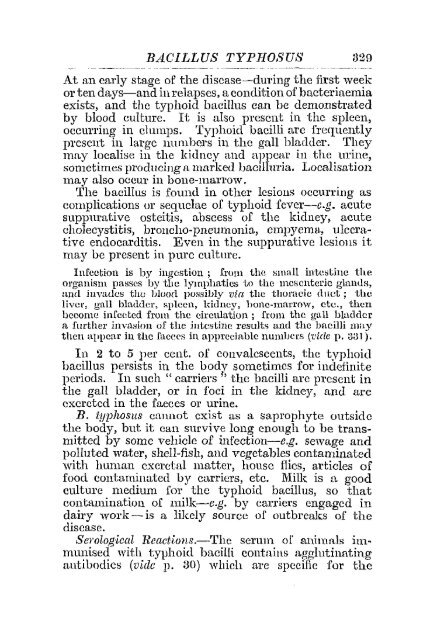AGf~ICULTURAL RESEARCH, PUSA.
AGf~ICULTURAL RESEARCH, PUSA.
AGf~ICULTURAL RESEARCH, PUSA.
Create successful ePaper yourself
Turn your PDF publications into a flip-book with our unique Google optimized e-Paper software.
BACILLUS TYPHOSUS 329<br />
At an early stage of the disease-during the first week<br />
or ten days-and in relapses, a condition of bacteriaemia<br />
exists, and the typhoid bacillus can be demonstrated<br />
by blood culture. It is also present in the spleen,<br />
occurring in clumps. Typhoid bacilli arc frequently<br />
present in large numbers in the gall bladder. 'fIley<br />
may localise in the kidney and appeal" in the urine,<br />
sometimes producing a marked bacilhn·ia. Localisation<br />
1l1ay also occur ill bone-lnal'l'Ow.<br />
'fhe bacillus is found in other lesions occurring as<br />
complications or sequelae of typhoid fever-c.g. acute<br />
suppnrative osteitis, abscess of the kidney, acute<br />
cholecystitis, brollcho-pneumonia, empyema, ulcerative<br />
endocarditis. Even in the suppurative lesions it<br />
may be present in pure culture.<br />
Infcction is by ingestion; from the small intcstinc thc<br />
organism passes by thc lymphatics to the mcsenteric glanus,<br />
and invades the lJluod pUi;sibly via the thuracic duet; tlw<br />
liver, gl\ll bladder, Rplcen, kiuney, honc-n1[t1'l'ow, etc., then<br />
beeomc infeded from thc circulation; from the gall bladdcr<br />
a furthcr inva:;ion of the illtestine l'esults and the bacilli lllay<br />
thell appear ill the facecs in appreciable llllIlllJers (vide p. a:Jl).<br />
In 2 to 5 per cent. of cOllvalcscents, the typhoid<br />
bacillus persists in the body sometimcs for indefinite<br />
periods. In such " carriers" the bacilli are pl'cscnt in<br />
the gall bladder, or in foci in the kidney, and are<br />
excrcted in the faeces or urine.<br />
B. typhOSU8 cannot exist as a saprophyte outside<br />
the body, but it can survive long enough to be transmitted<br />
by some vehicle of infection-e.g. sewage and<br />
polluted water, shell-fish, and vegetables contaminated<br />
with human excretal matter, house flies, articles of<br />
food contaminated by carriers, etc. Milk is a good<br />
culture medium for the typhoid bacillus, so that<br />
contamination of milk-e.g. by carriers engaged in<br />
dairy work - is a likely source of outbreaks of the<br />
disease.<br />
Serological React,ions.-'l'he serum. or aninlftls im.munised<br />
with typhoid bacilli contains agglutinating<br />
antibodies (vide p. aD) which are specific for the

















